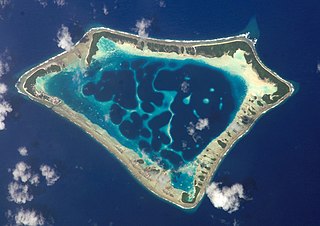
The Guadalcanal Campaign, also known as the Battle of Guadalcanal and codenamed Operation Watchtower by American forces, was a military campaign fought between 7 August 1942 and 9 February 1943 on and around the island of Guadalcanal in the Pacific theater of World War II. It was the first major offensive by Allied forces against the Empire of Japan.
Maroubra Force was the name given to the ad hoc Australian infantry force that defended Port Moresby, Papua New Guinea from the Japanese, and was involved in the Kokoda Track Campaign of the Pacific War, World War II. The force was established by the Allies under the codename "Maroubra", referring to the troops in the forward area, it was one of many units forming the body of the New Guinea Force, the main Allied army formation in the South West Pacific Area during 1942.

The Battle of Rabaul, also known by the Japanese as Operation R, was fought on the island of New Britain in the Australian Territory of New Guinea, in January and February 1942. It was a strategically significant defeat of Allied forces by Japan in the Pacific campaign of World War II, with the Japanese invasion force quickly overwhelming the small Australian garrison, the majority of which was either killed or captured. Hostilities on the neighbouring island of New Ireland are also usually considered to be part of the same battle. Rabaul was significant because of its proximity to the Japanese territory of the Caroline Islands, site of a major Imperial Japanese Navy base on Truk.
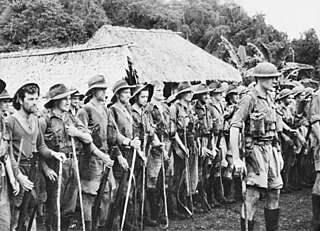
The Kokoda Track campaign or Kokoda Trail campaign was part of the Pacific War of World War II. The campaign consisted of a series of battles fought between July and November 1942 in what was then the Australian Territory of Papua. It was primarily a land battle, between the Japanese South Seas Detachment under Major General Tomitarō Horii and Australian and Papuan land forces under command of New Guinea Force. The Japanese objective was to seize Port Moresby by an overland advance from the north coast, following the Kokoda Track over the mountains of the Owen Stanley Range, as part of a strategy to isolate Australia from the United States.
Immediately after the fall of Singapore in 1942 certain Army circles argued that Japan should exploit her advantage and seek peace with Great Britain. The heart of this reasoning was the fact that Japan could not knock out both the United States and England, judging from such factors as a national strength and geographical location.
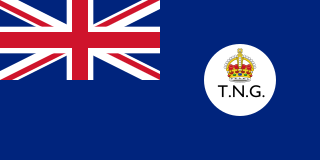
The Territory of New Guinea was an Australian administered territory on the island of New Guinea from 1920 until 1975. In 1949, the Territory and the Territory of Papua were established in an administrative union by the name of the Territory of Papua and New Guinea. That administrative union was renamed as Papua New Guinea in 1971. Notwithstanding that it was part of an administrative union, the Territory of New Guinea at all times retained a distinct legal status and identity until the advent of the Independent State of Papua New Guinea.

The New Guinea campaign of the Pacific War lasted from January 1942 until the end of the war in August 1945. During the initial phase in early 1942, the Empire of Japan invaded the Australian-administered territories of the New Guinea Mandate and Papua and overran western New Guinea, which was a part of the Netherlands East Indies. During the second phase, lasting from late 1942 until the Japanese surrender, the Allies—consisting primarily of Australian and US forces—cleared the Japanese first from Papua, then the Mandate and finally from the Dutch colony.
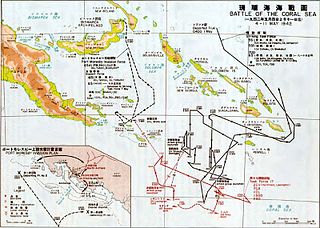
Operation Mo or the Port Moresby Operation was a Japanese plan to take control of the Australian Territory of New Guinea during World War II as well as other locations in the South Pacific with the goal of isolating Australia and New Zealand from their ally the United States. The plan was developed by the Imperial Japanese Navy and supported by Admiral Isoroku Yamamoto, the commander-in-chief of the Combined Fleet. The operation was ultimately abandoned.
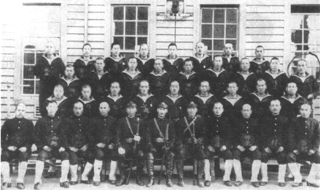
The invasion of Tulagi, on 3–4 May 1942, was part of Operation Mo, the Empire of Japan's strategy in the South Pacific and South West Pacific Area in 1942. The plan called for Imperial Japanese Navy troops to capture Tulagi and nearby islands in the British Solomon Islands Protectorate. The occupation of Tulagi by the Japanese was intended to cover the flank of and provide reconnaissance support for Japanese forces that were advancing on Port Moresby in New Guinea, provide greater defensive depth for the major Japanese base at Rabaul, and serve as a base for Japanese forces to threaten and interdict the supply and communication routes between the United States and Australia and New Zealand.

The 5th Division was an infantry division of the Imperial Japanese Army. Its call-sign was the Carp Division. The 5th Division was formed in Hiroshima in January 1871 as the Hiroshima Garrison, one of six regional commands created in the fledgling Imperial Japanese Army, and was destroyed in the battle of Okinawa in June 1945. Its personnel were drafted from Hiroshima, Yamaguchi and Shimane.
Aoba Detachment was the reinforced 4th Infantry Regiment/IJA 2nd Division, a part of the Seventeenth Army. The commander of the Aoba Detachment was Major General Yumio Nasu, the commander of the 2nd Division's Infantry Group. Unlike other detachments which were usually named after their commander, the Aoba Detachment is thought to have been named after Mt. Aoba in Sendai, hometown of the 4th Infantry Regiment.

New Guinea Force was a military command unit for Australian and native troops from the Territories of Papua and New Guinea serving in the New Guinea campaign during World War II. Formed in April 1942, when the Australian First Army was formed from the Australian I Corps after it returned from the Middle East, it was responsible for planning and directing all operations within the territory up until October 1944. General Headquarters Southwest Pacific Area Operational Instruction No.7 of 25 May 1942, issued by Commander-Allied-Forces, General Douglas MacArthur, placed all Australian and US Army, Air Force and Navy Forces in the Port Moresby Area under the control of New Guinea Force. Over the course of its existence, New Guinea Force was commanded by some of the Australian Army's most notable commanders, including Sydney Rowell, Sir Edmund Herring and Sir Leslie Morshead.

The Invasion of Salamaua–Lae, called Operation SR by the Japanese, was an operation by Imperial Japanese forces to occupy the Salamaua–Lae area in the Territory of New Guinea during the Pacific campaign of World War II. The Japanese invaded and occupied the location in order to construct an airfield and establish a base to cover and support the advance of Japanese forces into the eastern New Guinea and Coral Sea areas. The small Australian garrison in the area withdrew as the Japanese landed and did not contest the invasion.

Operation FS was the name of the Imperial Japanese plan to invade and occupy Fiji, Samoa, and New Caledonia in the south Pacific during the Pacific conflict of World War II. The operation was set to be executed in July or August 1942 following the MO, RY, and MI operations.

The 30th Brigade was a brigade-sized infantry unit of the Australian Army. Formed in December 1941, as part of the Militia, the unit was raised for service during the Second World War. Established in response to Japan's entry into the war, the brigade's subordinate units were established in several Australian states. Some of these had already been dispatched to New Guinea before the brigade's headquarters was established, although the majority arrived there in early 1942. Following their arrival, the brigade initially provided garrison troops to Port Moresby before later taking part in the fighting along the Kokoda Track during which elements took part in delaying actions around Kokoda and Isurava, before being relieved by units of the Second Australian Imperial Force. After the campaign began to turn in favour of the Australians, the Japanese withdrew north towards their beachheads around Buna and Gona, and elements of the brigade were recommitted to the fighting. In early 1943, the 30th Brigade was withdrawn back to Australia and was disbanded in July 1943, with its personnel being redistributed to other formations.

The Invasion of Buna–Gona, called Operation RI by the Japanese, was a military operation by Imperial Japanese forces to occupy the Buna–Gona area in the Territory of Papua during the Pacific campaign of the Second World War. The initial landings and advance on Kokoda occurred between 21 and 27 July 1942. The Japanese invaded and occupied the location in preparation for an overland attack on Port Moresby along the Kokoda Track. The landing marked the start of the Kokoda Track campaign. The landings were not directly opposed by land forces but were engaged by elements of Maroubra Force as they advanced on Kokoda. This initially included B Company of the 39th Battalion, patrols of the Papuan Infantry Battalion (PIB) operating in the area and a small number of the Australian New Guinea Administrative Unit (ANGAU) that became attached to the force. The Australians were initially repulsed near Oivi but subsequently regrouped to defend Kokoda in an initial battle there from 28–29 July.

The Battle of Isurava took place over the period 26 to 31 August 1942. Forming part of the Kokoda Track campaign of the Second World War, the battle involved military forces from Australia, supported by the United States, fighting against Japanese troops from Major General Tomitaro Horii's South Seas Detachment who had landed around Buna and Gona in Papua mid-July 1942, with the intent of capturing Port Moresby to the south via the overland route.

The Battle of Oivi–Gorari was the final major battle of the Kokoda Track campaign before the Battle of Buna–Gona. Following the capture of Kokoda by Australian forces on 2 November, the Allies began flying in fresh supplies of ammunition and food to ease the supply problems that had slowed their advance north after the climactic battle around Ioribaiwa, which coupled with reverses elsewhere, had stopped the Japanese advance on Port Moresby.

The Battle of Kokoda consisted of two engagements fought in late July – early August 1942. Forming part of the Kokoda Track campaign of the Second World War, the battle involved military forces from Australia, supported by the United States, fighting against Japanese troops from Major General Tomitaro Horii's South Seas Detachment who had landed around Buna and Gona in Papua mid-July 1942, with the intent of capturing Port Moresby to the south via the overland route.





